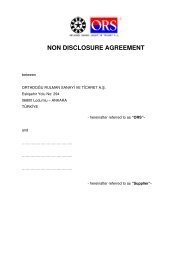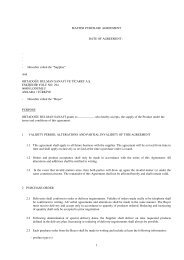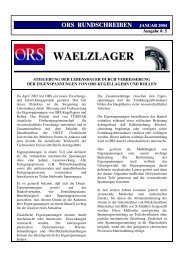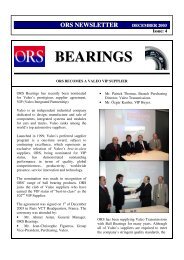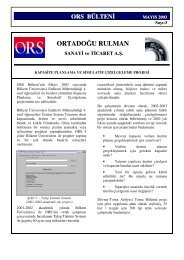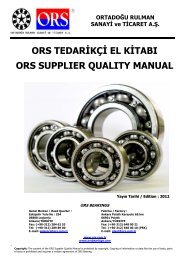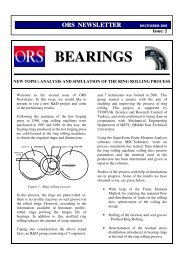For the first issue - ORS Bearings
For the first issue - ORS Bearings
For the first issue - ORS Bearings
You also want an ePaper? Increase the reach of your titles
YUMPU automatically turns print PDFs into web optimized ePapers that Google loves.
<strong>ORS</strong> NEWSLETTER JULY 2002<br />
Issue # :1<br />
BEARINGS<br />
FOR THE FIRST ISSUE...<br />
<strong>ORS</strong>, established in 1983, has taken technical<br />
assistance under <strong>the</strong> license agreement with STEYR<br />
WAELZLAGER. SKF/Austria has purchased<br />
STEYR in 1989, <strong>the</strong>n license agreement continued<br />
until <strong>the</strong> Spring of 1991. After <strong>the</strong> license expired<br />
<strong>ORS</strong> has been exclusively realizing all kinds of<br />
engineering, technical improvement, product<br />
design, die/tool design, process development and<br />
technical investment practices.<br />
The practices that are believed to be interesting to<br />
our customers will be prepared and released<br />
periodically under <strong>the</strong> name of “<strong>ORS</strong><br />
NEWSLETTER”.<br />
In our <strong>first</strong> release we would like to announce a<br />
R&D project and its invaluable results to our<br />
customers. The project, namely “THE<br />
OPTIMIZATION OF FORGING PROCESS AND<br />
FORGING DIES OF BEARING RINGS” was<br />
assisted/investigated by TUBITAK (Science and<br />
Technological Research Council of TURKEY) and<br />
performed under <strong>the</strong> supervision of METU (Middle<br />
East Technical University).<br />
As a measure of precaution to increasing prices of<br />
raw tube material used in production of bearing<br />
rings in world market, <strong>ORS</strong> has decided to invest in<br />
<strong>the</strong> "<strong>For</strong>ging Technology" and has purchased a hot<br />
forging press in 1996.<br />
Instead of cutting rings from raw tube material,<br />
rings are now being produced from raw rod<br />
material. In <strong>the</strong> hot forging press, initially, <strong>the</strong> rod is<br />
heated by induction coils, and through 3-4 stations<br />
(steps) formed into raw inner + raw outer ring set<br />
(main form). However, cost of <strong>the</strong> forging dies<br />
and <strong>the</strong>ir time-taking manufacture, as well as <strong>the</strong><br />
trial-and-error process for <strong>the</strong> design and test of<br />
new forging dies have indicated a need for an<br />
application of a simulation/optimization method.<br />
Instead of <strong>the</strong> trial-and-error process, a systematic<br />
research and development study has been done. In<br />
cooperation with Mechanical Eng. Department of<br />
METU/Ankara, and with <strong>the</strong> support of<br />
TUBITAK a research and development project<br />
has been started.<br />
The research and development group, consisting<br />
of 7 mechanical engineers, over <strong>the</strong> period of 3<br />
years systematically studied and analyzed <strong>the</strong><br />
process, <strong>the</strong> press itself and as well as <strong>the</strong> input<br />
material. This data has <strong>the</strong>n been transferred to <strong>the</strong><br />
MSC/Marc Auto<strong>For</strong>ge FEA (finite-element<br />
analysis) software.
The flowcurves of <strong>the</strong> materials mentioned above,<br />
used in <strong>the</strong> production of bearings, were<br />
determined at <strong>the</strong> ETH/Zurich, Switzerland<br />
material laboratories after a laborious study.<br />
Hot forging technology:<br />
SLUG<br />
As a result of this project;<br />
In order to forge a new material, before starting<br />
<strong>the</strong> design and production of dies/tools, <strong>the</strong><br />
simulation of <strong>the</strong> forging is executed using FEM<br />
(finite element method) in a complete virtual<br />
manner and <strong>the</strong> displacement of <strong>the</strong> material,<br />
<strong>the</strong> filling of <strong>the</strong> dies, <strong>the</strong> mechanical and<br />
<strong>the</strong>rmal forces applied to <strong>the</strong> die faces and <strong>the</strong>ir<br />
distribution are investigated and <strong>the</strong> process is<br />
optimized to determine <strong>the</strong> final design for <strong>the</strong><br />
forging dies after <strong>the</strong> interpretation of <strong>the</strong> results<br />
of <strong>the</strong> simulation.<br />
The detailed die designs are performed<br />
according to <strong>the</strong> main designs performed after<br />
<strong>the</strong> utilization of simulations in a fully virtual<br />
environment. And <strong>the</strong> dies are produced in <strong>ORS</strong><br />
facilities according to <strong>the</strong> revised die designs.<br />
The study for <strong>the</strong> forging application of a new<br />
part: <strong>the</strong> trial die investment and <strong>the</strong> time losses<br />
are prevented .<br />
While it were not always possible to judge <strong>the</strong><br />
production of parts by forging prior to this<br />
study, now we can get an easy and exact answer<br />
if <strong>the</strong> forging is applicable or not.<br />
PANCAKE<br />
MAIN FORM<br />
Waste Material Inner Ring Outer Ring<br />
The raw billet material is standardized and <strong>the</strong><br />
same part variety can be produced from a less<br />
number of different diameter raw billet material.<br />
<br />
<br />
<br />
! " <br />
# $ % &' () * + , )<br />
% &' () * + <br />
( % - . /<br />
<strong>ORS</strong> BEARINGS<br />
<br />
<br />
<br />
<br />
0 /1 ! 2 , <br />
* 0 /1<br />
! " <br />
# $ % &' () * + *<br />
% &' () * + * &0 3 4 +<br />
( % 5 /- . /



